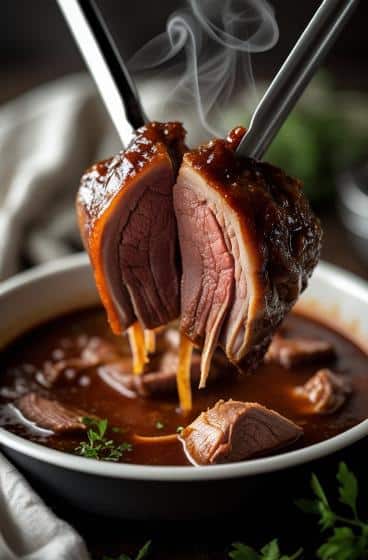There’s something ancient and soulful about cooking oxtail on the stove. It ain’t just a recipe—it’s a ritual. The kind that makes neighbors pause at your doorway. That smell… warm, sticky, and deep like a memory you didn’t know you had. I still remember the first time I made it for my gran—she said it tasted like “home but louder.”
This ain’t your average weeknight stew. This is an all-out flavor brawl. Fat, collagen, and bone marrow dancing together in a pot like they were born to make magic. Stove-top oxtail is slow, yes, but not sluggish. It simmers, thickens, transforms—right there on your burners, no fancy oven nonsense needed.
What makes this one special? It’s that stovetop attention—how it lets you listen to your food. Stir it, smell it, fuss over it like it’s a child you’re raising into something glorious. Plus, it’s loaded with techniques that coax out layers of flavor. Searing. Deglazing. Braising. A trifecta of flavor engineering. You won’t just make this—you’ll craft it.
Let’s do it proper.
Ingredients & Substitutions
The magic of oxtail’s all in the layering—aromatics, spices, and a low ‘n slow simmer. But if you’re short on something or dealing with picky eaters, there’s wiggle room.
Here’s your lineup:
| Ingredient | Purpose in Dish | Substitution or Notes |
|---|---|---|
| Oxtail (3–4 lbs) | Rich, gelatinous meat + collagen | Beef short ribs or neck bones (less gelatin, still tasty) |
| Onion (1 large, chopped) | Sweet base flavor | Shallots or leeks |
| Garlic (6 cloves, smashed) | Depth + sharpness when browned | Garlic paste (1 tbsp), roasted garlic for milder tone |
| Carrots (2 large, sliced) | Sweetness + balance | Parsnips or sweet potato chunks |
| Celery (2 stalks, chopped) | Aromatic balance | Fennel or omit for simpler profile |
| Tomato paste (2 tbsp) | Umami + body in sauce | Canned tomatoes (crushed, 1/2 cup) |
| Worcestershire sauce (2 tbsp) | Umami bomb, caramel edge | Soy sauce + bit of molasses (1:1 sub) |
| Brown sugar (1 tbsp) | Caramelization + richness | Honey or maple syrup |
| Scotch bonnet (1, whole) | Heat + floral aroma | Habanero or dried chili, adjust heat to taste |
| Thyme (2 sprigs or 1 tsp dried) | Earthy backbone | Rosemary or oregano |
| Allspice (1 tsp ground) | Warm, island-y undertone | Cinnamon + nutmeg (pinch each) |
| Bay leaves (2) | Long-cook aroma stabilizer | Curry leaves or omit |
| Beef stock (4 cups) | Braising liquid + flavor foundation | Water + bouillon cube or vegetable broth |
| Neutral oil (2 tbsp) | Searing the meat | Avocado oil, canola, or ghee |
| Salt + black pepper | Season to taste | Always start light, adjust later |
| Cornstarch slurry (1 tbsp cornstarch + 2 tbsp water) | Thicken at the end | Optional, if you like a thicker gravy |
Notes on Selection
Use fresh herbs if you can. Dried thyme works, but fresh punches louder. Don’t skimp on the tomato paste—get it browned for that proper concentrated umami. And the oxtail? Go for thick cuts with visible marrow. That bone’s not just decorative—it’s your built-in flavor bomb.
Step-by-Step Instructions
Step 1: Pat dry and season the oxtail
Get your oxtail nice and dry—paper towels work. Wet oxtail won’t brown, it’ll just sulk in steam. Generously salt and pepper it. If it looks under-seasoned, it is.
Pro tip: Let seasoned oxtail sit for 10 minutes at room temp. Salt penetrates better that way.
Step 2: Brown the meat
Heat oil in a deep, heavy-bottomed pot over medium-high. Work in batches—don’t crowd ’em. Sear each piece until it’s dark brown and crusty on all sides.
That crust? That’s where flavor lives. The Maillard reaction’s not optional—it’s gospel.
Mistake to avoid: Rushing. Undercooked browning = bland stew. Take your time.
Step 3: Build the flavor base
Remove oxtail, toss in onions, carrots, and celery. Sauté for 5–7 minutes till soft and golden. Add garlic last—it burns quick. Stir in tomato paste and brown sugar, cooking till paste darkens and sticks.
Deglazing moment: Splash a bit of beef stock or water to scrape those flavorful brown bits off the bottom. That’s your flavor goldmine.
Step 4: Spice it up
Add Worcestershire sauce, thyme, allspice, bay leaves, and the whole Scotch bonnet (don’t cut it unless you want FIRE). Stir and let everything mingle for a minute.
Variation: Want smokiness? Add a pinch of smoked paprika or a chopped chipotle in adobo.
Step 5: Return oxtail and simmer
Nestle oxtail back in. Pour in beef stock till it just covers the meat. Bring to a simmer, then reduce heat to low.
Cover with a lid slightly ajar, and let it do its thing for 3 to 4 hours. Stir every 30–40 mins, check liquid levels. Add stock if it’s getting dry.
Common mistake: Boiling instead of simmering. Keep it low—bubbling too hard will make the meat tough, not tender.
Step 6: Reduce and thicken
Once meat is tender and falling off the bone, remove lid and let sauce reduce uncovered for 20–30 mins. If you like it thicker, stir in the cornstarch slurry. Let it simmer another 5–10 mins.
Meat should be glossy, coated, and soft enough to tear with a spoon.
Cooking Techniques & Science
Why sear first?
Searing doesn’t “lock in juices” (myth alert!), but it creates those browned compounds—called Maillard products—that deepen flavor like crazy. It also adds texture, so the meat isn’t mushy post-braising.
The braise equation
Braising = low heat + moist environment + time. The connective tissue in oxtail—rich in collagen—melts into gelatin, which thickens the sauce naturally and gives it that luscious mouthfeel. Think silk, not soup.
Aromatics matter
Thyme and allspice aren’t just for show. They lift the dish’s depth, making it feel “complete.” Bay leaves add subtle bitterness to round out sweetness.
Storage & Reheating
Storage: Let it cool fully. Store in airtight container, fridge up to 4 days. It actually tastes better the next day—flavors marry overnight.
Freezing: Yep. Freeze for up to 3 months. Defrost in fridge, reheat gently over stove. Don’t microwave, it’ll separate.
Reheating tip: Add a splash of broth when reheating to loosen the sauce.
Variations & Substitutions
- Spicy version: Slice the Scotch bonnet open for max heat.
- No beef stock? Use mushroom broth + soy sauce for a vegetarian-ish base (if subbing meat entirely).
- Gluten-free: It already is! But make sure Worcestershire sauce is GF-certified.
- Caribbean style: Add pimento seeds, green onions, and a touch of browning sauce near the end.
Tools that matter
- Dutch oven or heavy pot: Crucial. Thin pots scorch.
- Tongs: For flipping oxtail safely without piercing.
- Wooden spoon: Gentle on the pot, strong enough to scrape fond.
Serving & Pairing Suggestions
Presentation
Serve oxtail in a shallow bowl, bones peeking through rich brown sauce. Top with chopped parsley or green onion if you’re feeling fancy.
Set it over:
- Steamed white rice or rice and peas
- Creamy mashed potatoes
- Buttery polenta
- Coconut grits, if you’re feeling Southern
Pair with:
- Roasted plantains (sweet + salty balance)
- Sautéed greens like callaloo or spinach
- Crusty bread to mop up every drop
Drink pairings:
- Red wine with body (Cab Sauv or Syrah)
- Sorrel drink or ginger beer for authenticity
- Dark rum cocktail if you’re going all in
Best Time to Serve This Dish
When it’s cold, grey, and your soul needs soothing. When company’s over and you need something rich but low-effort. Or Sundays. This is a Sunday dinner dish, no question.
Serve it when you’ve got time to sit and eat, not rush. It demands respect—and a nap after.
Conclusion
Oxtail on the stove is a slow seduction. A transformation. Cheap, tough cuts turned luxurious with little more than patience, heat, and love. You don’t need an oven, just a pot, some time, and the courage to let flavors build layer by layer.
Don’t skip the sear. Don’t rush the simmer. Don’t skim the fat too early—that’s flavor.
The joy’s in the wait. And the smell that crawls under your skin, telling you this one’s gonna be special.
Final tips:
- Let it rest before serving—sauce thickens beautifully.
- Taste after the reduction, not before—you’ll over-salt otherwise.
- Next-day leftovers? Even better. Trust me.
FAQs
1. Can I make this in a pressure cooker instead?
Yes, and it’ll cut your cook time down to about 45–50 minutes. But you’ll lose some of that thick, reduced sauce depth. If using pressure cooker, finish uncovered on stove for 15 minutes to reduce.
2. Why is my oxtail still tough after 2 hours?
It just ain’t ready yet. Keep simmering. Some oxtail takes 3–4 hours depending on size and collagen content. Low and slow wins the race.
3. Can I make this dish ahead of time?
Absolutely. It’s better the next day. The sauce thickens, flavors deepen, and it reheats beautifully.
4. How do I control the spice level?
Leave the Scotch bonnet whole for subtle heat, or remove entirely for a mild version. Want fire? Slice it open or add crushed red pepper flakes.
5. Can I substitute turkey or chicken for oxtail?
Not really. You’d lose the signature richness from the collagen and bone marrow. For lighter meat, try stew chicken instead—but know it’s a different experience.
Now go get yourself some oxtail. And a deep pot. And clear your afternoon. Trust the process.

